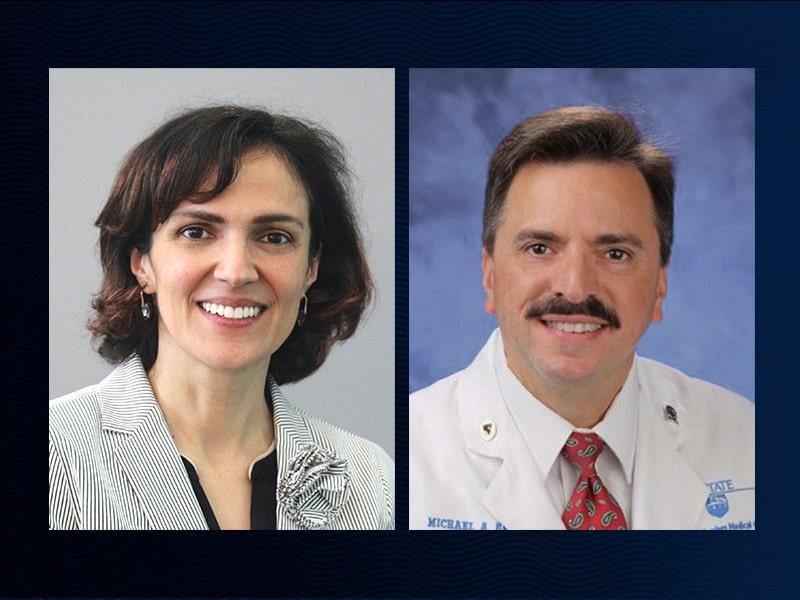
When the coronavirus pandemic hit southeastern Pennsylvania, healthcare institutions and higher education were faced with many challenges never before seen in this country. In Berks County alone, there were more than 126,000 cases and 1,765 deaths from the pandemic. However, the pandemic also presented an opportunity for a unique collaboration between a Penn State Berks professor and a Penn State College of Medicine professor to conduct a study on redesigning pandemic-related healthcare facilities.
Before the pandemic, Dr. Sadan Kulturel-Konak, professor of management information systems at Penn State Berks, researched zone-based layouts, primarily in manufacturing settings. The primary application areas of her optimization research include designing and redesigning facilities to provide significant economic benefits for industries.
She explains that she always wanted to apply her research to healthcare facilities and was looking for collaborators, so she reached out to Dr. Michael Bruno, who wears many hats, including professor of radiology and medicine at Penn State College of Medicine. Bruno was intrigued by the idea of collaborating, and they began working together on the study.
“We were still in the throes of the pandemic at the time,” Bruno said. “It was about one year in, and we had gotten past the worst of it. We were looking at how we could have designed facilities that could have made things easier. We identified lots of areas that need to be more flexible.“
Bruno gives the example of Penn State Health Milton S. Hershey Medical Center relocating the Emergency Department’s radiology reading room to the hospital’s basement and developing protocols for remote-only consultation between radiologists and emergency physicians.
In addition to his role as professor, Bruno has served as vice chair for radiology quality and safety at the Milton S. Hershey Medical Center for the past 18 years. He helped Kulturel-Konak make connections with other healthcare administrators working in operations who are responsible for facility layout. For the most part, those they spoke with were not necessarily looking at the facility layout from a holistic perspective.
“We wanted to determine how we can apply what we learned during the pandemic and make healthcare facilities more resilient and sustainable. You can’t change everything all at once, but how can we make that transition easier,” Kulturel-Konak said.
“There is a huge interface between people and structures and people and devices, what we sometimes call human factors engineering,” Bruno explained. “This is something we are very interested in at Penn State College of Medicine to develop greater expertise in how people interact with structures and gadgets.
“If you look at the way doctors are studying artificial intelligence, they are looking at having the AI replace some human activities, and they’re asking: How does the AI perform by itself compared to a human? But I think the real question is: How does the human–machine interaction improve the individual performance of the human and machine?” Bruno said. “Part of that is how humans and machines interact together. You might find that there are highly effective ways in which humans can interact with AI that are greater than the sum of its parts. It’s about making the environment conducive to the functioning that’s needed.”
For Kulturel-Konak, the goal of the research was to test the idea of having similar functionalities grouped in health care and gauge whether various departments are receptive to that idea.
Bruno said Kulturel-Konak’s ideas brought a lot of interconnectivity to the facility design. “It would be nice to have a new lab where we can test ideas. These concepts aren’t limited to a pandemic; they could also be used in catastrophes where there are mass casualties.”
Kulturel-Konak and Bruno say they may publish more on this topic, focusing on how they can account for human factors – patients and healthcare providers – in future research.
“It’s been wonderful to have a partnership with someone with different areas of expertise,” stated Bruno.
Kulturel-Konak is an academic member elected to the College Industry Council on Material Handling Education (CICMHE) and was invited to write an article about their study. The article titled “Designing Pandemic Resilient Healthcare Facilities” was published in the Q1 issue of MHI Solutions.
Kulturel-Konak is a professor of management information systems and director of the Flemming Creativity, Entrepreneurship, and Economic Development (CEED) Center at Penn State Berks. She also holds an affiliate faculty position at the Penn State Harold and Inge Marcus Department of Industrial and Manufacturing Engineering, College of Engineering, Penn State University Park. For more information, contact her at [email protected].
Bruno is a professor of radiology and medicine, vice chair for radiology quality and safety, and chief of the Division of Emergency Radiology at Penn State College of Medicine and Hershey Medical Center.




